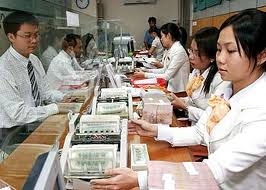Everyone watching the rate game
 |
| illustration photo |
In early September 2011, the State Bank enacted Instruction 02/CT-NHNN to scale up checks on the implementation of ceiling deposit rate regulations at local banks which also regulate severe punishments towards regulation violators.
A Hanoi bank staff said after Instruction 02’s enactment, the deposit surplus at her branch office shed slightly.
“For example, the figure stood at VND370 billion ($17.8 million) later last week and even exceeded VND400 billion ($19.3 million) at some points of time. After the instruction came into force, the figure slid to just VND340 billion ($16.4 million) today,” she said.
Deputy general director of a Ho Chi Minh City-based commercial joint stock bank with VND3 trillion ($145 million) in chartered capital, said depositors would not want to turn to small banks if the ceiling deposit rate was equally applied by banks.
“Things keep going as usual at our diverse branch offices. Some branches reported a rise in deposit amount, while it sank slightly at some others,” said OCB general director Trinh Van Tuan,
Tuan said unpredictable gold prices made people cautious with their buying decisions. Besides, converting dong into dollars to enjoy 2 per cent per year deposit rate would not be a good option given central bank’s recent message to keep the dong-dollar exchange rate volatility at not more than one percentage point until the year’s end.
Tuan, however, agreed that it would be harder for smaller banks to attract deposits than big banks when the ceiling deposit rate was the same at banks.
Ho Chi Minh City-based Sacombank chairman Dang Van Thanh said the central bank should be consistent in its commitment to bring down bank ceiling deposit rates to regulated 14 per cent, per year.
“In doing so, it is possible to pull the dong lending rate down to 17-19 per cent, per year and we can expect the [lending] rate slide further in the face of easing inflation,” said Thanh.
A National Financial Supervisory Committee executive said a possible property market and stock market rebound was unlikely.
“Hence, putting money at banks to enjoy the ceiling 14 per cent, per year interest rate is still the most profitable and safe investment channel,” said the expert.
What the stars mean:
★ Poor ★ ★ Promising ★★★ Good ★★★★ Very good ★★★★★ Exceptional
 Tag:
Tag:
Related Contents
Latest News
More News
- Securing capital and efficiency for Vietnam’s 2026-2030 growth ambitions (December 17, 2025 | 10:00)
- Energy sector in need of blended finance mechanisms (December 17, 2025 | 09:00)
- Vietnam still has room to mobilise capital for sustainable growth (December 17, 2025 | 08:57)
- Long-term capital seen as key hurdle to green growth (December 16, 2025 | 08:00)
- Gold prices swing amid tax debate and import uncertainty (December 15, 2025 | 18:04)
- Agribank frames bank credit as catalyst for green growth (December 15, 2025 | 17:59)
- Vietnam’s green transition demands collective financial action (December 15, 2025 | 12:00)
- VIR workshop highlights capital and policy for sustainable development (December 15, 2025 | 11:00)
- Promoting digital assets initiative in Vietnam (December 13, 2025 | 09:30)
- Experts flag gaps as national financial strategy under review (December 12, 2025 | 15:13)
























 Mobile Version
Mobile Version